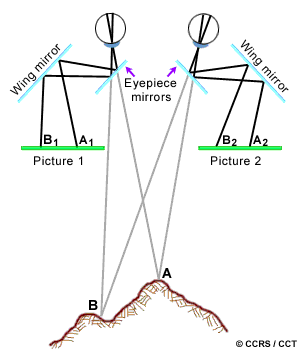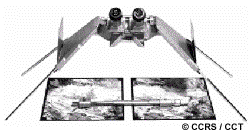
Natural Resources Canada > Earth Sciences Sector > Priorities > Canada Centre for Remote Sensing
Stereoscopy
3.1 Stereoscopy

hand drawn stereo pair |
The first attempt to produce a stereoscopic image was undertaken by Giovanni Battista della Porta
around the year 1600. More recently, artists such as Magritte in "Man with a Newspaper" (1928, The Tate
Gallery, London) and Dali in "Christ of Gala" (1978, Museum Ludwig, Cologne) have created
stereo-paintings by depicting left and right perspectives. Drawing and painting techniques were commonly used until the 1800's when they were rendered obsolete by the invention of photography.

First stereoscopic viewer |
The invention of photography in 1822 prompted the development of stereoscopes. The first stereoscopic viewer, a simple two-mirrored device, was proposed by Sir Charles Wheatstone in 1838. This simple device allowed a viewer to observe stereoscopic pictures larger than the span that separates two human eyes, which is approximately 5.6 cm.
His idea was improved upon by Sir David Brewster who, in 1849, constructed a practical stereoscope using prisms instead of the mirrored model designed earlier.

Stereoscope using prisms |
Oliver Wendell Holmes improved the stereoscope by adding convex lenses as eyepieces (Okoshi, 1976).
Such lenses improve depth perception greatly. When viewing a flat image, it is the "accommodation" cue
which tells the observer that it is a flat picture. Adding a convex lens makes accommodation less
significant. This allows depth sensation due to binocular parallax and convergence to be emphasized.

Stereoscopic viewing system |
Stereoscopes allow us to see in three dimensions because they reinforce the physiological cues of
"binocular parallax" and "convergence". A stereoscopic viewing system forces our eyes to see two images taken from different viewpoints at the same time. Modern stereoscopes range from relatively cheap pocket models that use only convex lenses, to more complex models that use mirrors, prisms and
convex lenses.

Modern stereoscopes |
Cartographers, engineers, foresters, geologists, hydrologists and scientists from many other disciplines
use stereoscopes. In order to increase their qualitative understanding of the environments they are
researching, scientists use stereoscopes both in the field and in the office. Stereo viewing is also
necessary for most mapping purposes.

Analogue stereoplotter |
The last 40 years have seen the development of stereoplotting systems. The concept for these systems was developed in 1957 by U.V. Helava when he was employed at the National Research Council
of Canada.
Photogrammetric principles - colinearity and coplanarity conditions - mathematically solve the relationship between image coordinates in a 2-D image reference system and the ground coordinates of objects in the 3-D 'real' world. The application of these mathematical concepts, in tandem with the development of computers, have allowed the generation of analytical and digital stereoplotting systems. The hardware and software used to transform information from 2-D digital imagery into 3-D data has allowed the mapping process to become increasingly automated. Reference material on analytical and digital stereoplotters can be found in such texts as the latest edition of the "Manual of Photogrammetry" published by the American Society on Photogrammetry and Remote Sensing.

Digital stereoplotter |
Digital photogrammetric systems enable stereo viewing to be done on a computer screen using a system
of optics and digital stereo images. Digital stereo images are separated either spatially, radiometrically or temporally. Spatial separation is achieved by the use of two monitors or a split screen and an optical
system using mirrors and/or convex lenses. Radiometric separation can be achieved by anaglyphic or
polarization techniques and coloured or polarized lenses. Temporal separation is achieved by alternating the display of the two images.

Temporal separation |
Articles by Helava (1988), Dowman et al., (1992) and Heipke (1995) also present state of the art digital
photogrammetric workstations.
| 